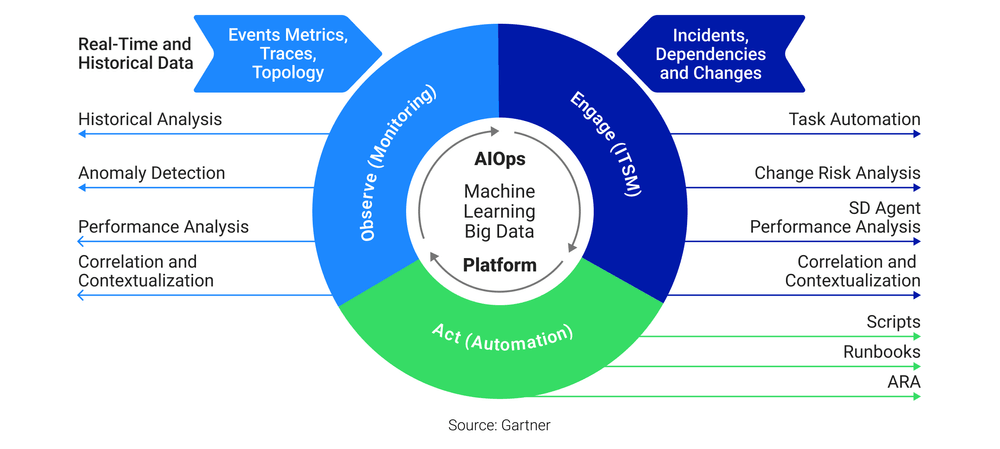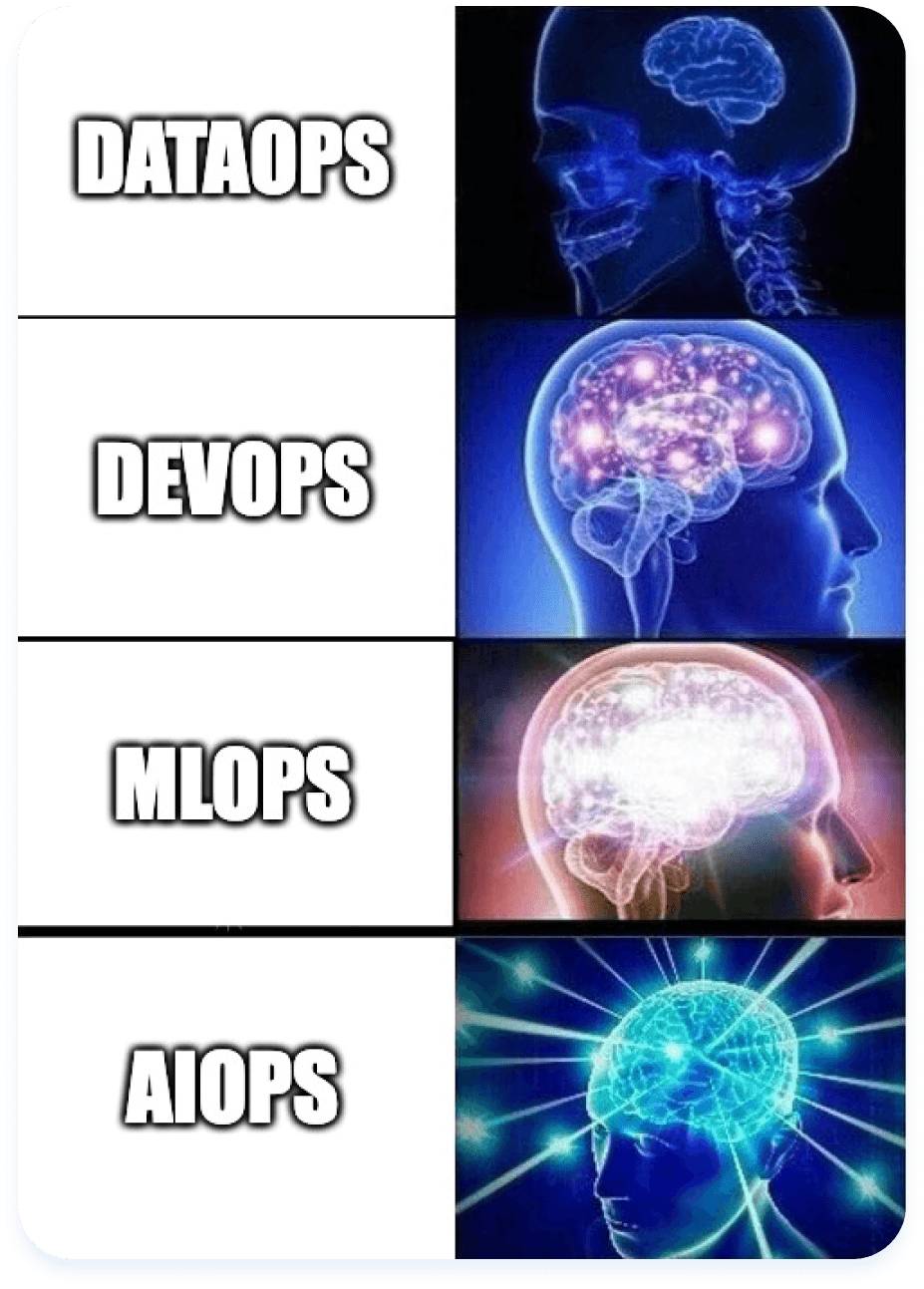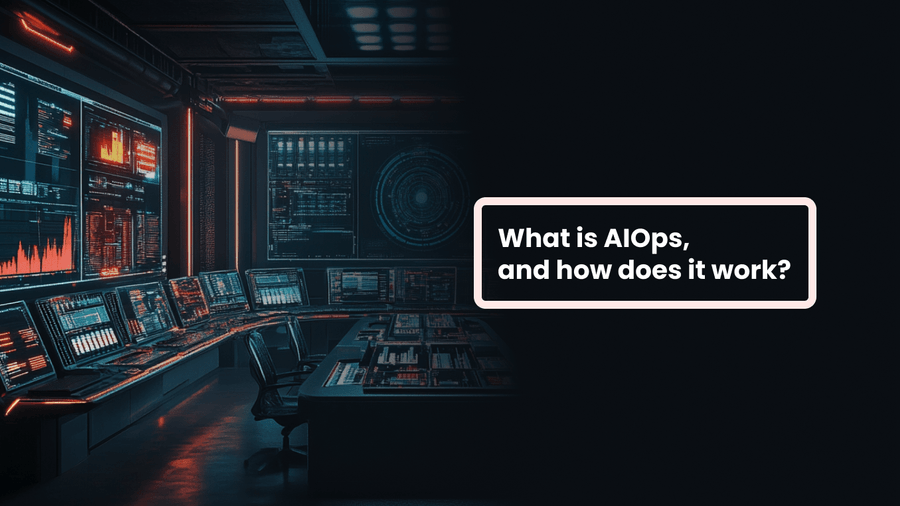AIOps explained
Forrester predicts that in 2025, the adoption of AIOps will triple as tech leaders struggle to keep IT complexity under control. The reason? Rising technical debt.
Right now, more than half of technology decision-makers are already facing moderate to severe levels of it. By 2026, that number will rise to 75%, driven by the rapid adoption of AI-driven solutions. Keeping systems efficient while scaling AI is becoming a real challenge – and businesses need smarter ways to stay in control.
That’s why AIOps is emerging as one of the key trends for the upcoming future. It helps organizations manage IT operations more intelligently, reducing manual effort and preventing system overload.
So, what exactly is AIOps, how does it work, and what can it do for businesses? Let’s get into it.
AIOps – a luxury or a new necessity?
AIOps, short for artificial intelligence for IT operations, is the use of AI and machine learning to improve how IT systems are monitored and managed.
But why does this matter now more than ever? As businesses rely more on digital tools, IT environments are becoming increasingly complex, making it harder to detect, analyze, and resolve issues manually. AIOps helps by using smart automation to handle these challenges efficiently.
Instead of waiting for problems to surface, AIOps works behind the scenes, analyzing massive amounts of data in real time. It uses machine learning models to recognize patterns, predict potential failures, and even take action before issues escalate. Natural language processing helps it understand logs, alerts, and system messages, reducing the noise and highlighting what really matters.
The result? Less time spent reacting to incidents and more time improving systems. For businesses, this means fewer disruptions, faster problem resolution, and an IT team that isn’t stuck putting out fires all day.
AIOps components
As we discussed earlier, AIOps processes massive amounts of IT data to detect issues, predict failures, and automate responses. This happens through several key components that work together to analyze and act on information in real time.
Algorithms
Algorithms encode IT expertise, business rules, and operational logic. They help AIOps platforms detect patterns, prioritize incidents, and adjust system behavior based on real-time data. As conditions change, algorithms refine performance and security decisions without manual intervention.
Machine learning
Machine learning enables AIOps to recognize trends, detect anomalies, and identify the root cause of failures. Techniques like supervised and unsupervised learning help correlate events across different systems, reducing the time IT teams spend diagnosing problems.
Data aggregation & analytics
AIOps collects data from logs, metrics, cloud services, and other sources. Analytics then process this raw data to highlight trends, predict capacity needs, and detect unusual system behavior before it causes disruptions.
Automation & orchestration
AIOps doesn’t just flag issues – it can also resolve them automatically. Automated workflows adjust system resources, restart failed services, or trigger alerts for human intervention when needed. For example, if traffic spikes beyond expected levels, AIOps can allocate additional computing power without waiting for manual input.
Visualization
Dashboards and reports help IT teams monitor system performance and track incidents. Instead of analyzing raw logs, they get clear visuals of trends, risks, and ongoing issues, allowing them to make quick, informed decisions.
Each of these components plays a specific role in making AIOps effective. Together, they reduce manual effort, improve system reliability, and help businesses prevent downtime instead of just reacting to problems. Two types of AIOps
AIOps solutions fall into two categories: domain-centric and domain-agnostic. The difference lies in how they process and analyze IT data.
Domain-centric AIOps focuses on a specific area like cloud management, network performance, or application monitoring. These tools are trained on specialized datasets, making them precise in detecting and resolving issues within their domain. For example, a domain-centric tool for network monitoring can identify whether slow performance is caused by a DDoS attack or a misconfigured router.
Domain-agnostic AIOps works across multiple IT environments, collecting and analyzing data from different systems – such as security, storage, and applications. By correlating events from various sources, it helps IT teams detect system-wide patterns, predict failures, and automate responses. This makes it useful for organizations managing complex infrastructures with interconnected services.
Businesses often use both types together: domain-centric AIOps for in-depth analysis of critical systems and domain-agnostic AIOps for a broader view of IT operations.

Observe, engage, act – key stages of AIOps
AIOps works like a well-trained security system – it doesn’t just sound an alarm when something breaks but constantly watches, analyzes, and takes action to prevent issues before they cause disruptions.
It follows three key stages: Observe, Engage, and Act. Each step ensures IT systems remain stable, responsive, and efficient.
Observe
IT systems generate enormous amounts of data – logs, metrics, network activity, security events. AIOps collects this data from different sources and processes it in real time. It detects patterns, identifies anomalies, and helps IT teams understand what’s happening across their infrastructure.
For example, if an application slows down, AIOps doesn’t just report high latency. It traces every request, maps dependencies, and determines whether the issue is a failing database, an overloaded server, or a misconfigured network.
Engage
Traditional monitoring tools generate floods of alerts, many of which are redundant or irrelevant. AIOps filters out the noise. It prioritizes critical issues, groups related events, and routes them to the appropriate teams.
If a database failure triggers errors across multiple applications, AIOps doesn’t send separate alerts for each affected service. Instead, it connects the dots, pinpoints the root cause, and suggests a resolution. In many cases, it even initiates automated workflows, resolving minor issues before they require human intervention.
Act
AIOps isn’t just about detection – it’s about action. Once it identifies a recurring issue, it automates responses. It can scale resources, restart services, apply patches, or adjust configurations without waiting for manual input.
For example, if a cloud server reaches its capacity limit, AIOps can automatically deploy additional instances. If an application shows early signs of failure, it can restart components before users experience downtime. Over time, the system learns from past incidents, improving its ability to prevent future disruptions.

AIOps vs. DevOps vs. MLOps vs. DataOps
AIOps, DevOps, MLOps, DataOps – Ops everywhere, but what’s the difference? While they all revolve around optimizing processes, each serves a distinct purpose. Let’s break it down.
AIOps vs. DevOps
DevOps bridges the gap between development and operations teams, making software development faster and smoother. It automates coding, testing, and deployment, ensuring quick and reliable software updates.
AIOps, on the other hand, focuses on keeping IT systems healthy. Using AI and big data, it analyzes system performance, detects anomalies, and resolves issues before they escalate. When combined, DevOps and AIOps create a powerful system – one that builds software efficiently and keeps it running without disruptions.
AIOps vs. MLOps
MLOps helps data scientists and engineers deploy and manage machine learning models in production. It ensures ML applications are trained, tested, and integrated smoothly into real-world systems.
AIOps applies machine learning to IT operations, analyzing system data to predict and prevent failures. While MLOps fine-tunes ML models, AIOps uses those models to keep IT environments stable.
AIOps vs. DataOps
DataOps is all about managing data. It creates efficient data pipelines that move and process information across systems to ensure businesses have accurate, well-structured data ready for analytics and decision-making.
AIOps relies on these data pipelines but takes things further. It analyzes IT data, spots issues, and resolves them automatically. DataOps delivers clean data, AIOps makes sure the systems processing that data don’t fail.

Where can you use AIOps?
Now, let’s look at where AIOps delivers the most impact:
Root cause analysis
Fixing IT problems isn’t just about reacting quickly; it’s about solving the actual cause. AIOps pinpoints what triggered an outage, error, or slowdown, helping teams address the issue at its source instead of repeatedly fixing symptoms.
For example, if a network failure occurs, AIOps can track it back to a misconfigured load balancer or a failing database node – allowing teams to resolve it and prevent future incidents.
Anomaly detection
Not all issues come with a flashing warning sign. Some start as small, unusual behaviors that grow into major failures. AIOps continuously scans system data, detecting deviations that might indicate security threats, system misconfigurations, or performance drops. This early detection prevents unexpected downtime, data breaches, and compliance violations.
Performance Monitoring
Applications today run on a mix of cloud, on-prem, and hybrid environments, often with multiple layers in between. Keeping track of what’s running where – and how well – can be a challenge.
AIOps monitors infrastructure, applications, and networks in real time, providing clear insights into availability, response times, and usage. It also connects the dots between system events, helping teams see patterns and trends instead of chasing isolated alerts.
Cloud Adoption and Migration
Moving to the cloud isn’t a one-time switch – it’s an ongoing process with shifting dependencies. AIOps maps out the connections between workloads, APIs, and microservices. This helps businesses transition without breaking critical services and also reduces risks during cloud migration by identifying potential bottlenecks before they cause disruptions.
DevOps Support
Speed is key in DevOps, but so is control. While development teams work on continuous releases, IT teams must ensure stability. AIOps bridges this gap by automating infrastructure management, analyzing deployment impacts, and preventing misconfigurations from escalating into major failures. It keeps everything running without adding extra manual work.
Here’s what businesses gain from adopting it
Automated operations are just one part of what AIOps brings to the table. Here’s what else it delivers:
Lower operational costs
Instead of hiring more staff to keep up with growing IT demands, AIOps automates issue detection and resolution. It minimizes time spent on manual troubleshooting, reduces the risk of costly downtime, and helps businesses allocate resources efficiently.
Faster mean time to repair (MTTR)
The longer an issue remains unresolved, the more damage it causes. AIOps reduces incident resolution time by identifying root causes in seconds and suggesting the best course of action. This means less time firefighting and more time focusing on innovation.
Clearer system visibility and collaboration
IT operations involve multiple teams – security, infrastructure, DevOps, and governance – all needing access to accurate, real-time data. AIOps provides a shared view of system health, which makes it easier to spot risks, coordinate responses, and keep everything running smoothly.
Predictive issue management
Instead of waiting for something to break, AIOps predicts failures based on historical patterns and real-time data. It prioritizes alerts based on urgency, allowing IT teams to address potential disruptions before they escalate into major outages.
Bottom line
To sum up, AIOps is the use of AI and machine learning to manage IT operations more efficiently. The technology processes vast amounts of data in real time, detecting issues, predicting failures, and automating responses through machine learning, analytics, and orchestration.
AIOps can be applied to cloud management, security monitoring, and performance optimization, reducing downtime and manual workload. Businesses that implement it gain faster issue resolution, improved system reliability, and better resource allocation.
With IT environments becoming more complex, AIOps will likely shift from an advantage to a necessity.




